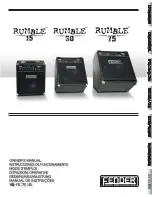
TEC-B-01 User Manual
____________________________________________________________________________________________________________________________
__________________________________________________________________________________
version 1.1
page 26
9. Appendix
9.1.
Theory of Operation
The standard configuration for voltage clamping oocytes is the two electrode voltage clamp
arrangement (Stühmer, 1992; Stühmer et al. 1992; Dietzel et al., 1992; Stühmer, 1998). In contrast to
previously described clamp systems (for review see Smith et al., 1985) the amplifiers for oocyte
clamping must meet special requirements since oocytes are very large cells with a high membrane
capacity (up to 100-500 nF) and large membrane currents (up to 100 µA and more).
Voltage clamp instruments are closed loop control systems with two inputs external to the control
loop. An electronic feedback network is used to force the membrane potential of a cell to follow a
voltage command (setpoint input) as fast and as accurately as possible in the presence of incoming
disturbances (disturbance input, correlated with the activities of the cell e.g. activation of ion
channels). This is achieved by injecting an adequate amount of charge into the cell. The current
injected by the clamp instrument is a direct measure of the ionic fluxes across the membrane (Ferreira
et al., 1985; Jack et al., 1975; Ogden, 1994;Smith et al., 1985).
The performance evaluation and optimal tuning of these systems can be done by considering only the
command input since the mathematical models (set point transfer function and the disturbance transfer
function, see Froehr, 1985; Polder; 1984; Polder and Swandulla, 1990; Polder, 1993; Polder and
Houamed, 1994; Polder and Swandulla, 2001) are closely related. Modern control theory provides
adequate solutions for the design and the optimal tuning of feedback systems (Froehr, 1985).
Most voltage clamp systems are composed only of delay elements, i.e. elements which react with a
retardation to a change. This type of closed loop systems can be optimized easily by adequate shaping
of the "frequency characteristic magnitude" (
/F(jw)/
) of the associated transfer function
F(s)
(output to
input ratio in the frequency domain =
LAPLACE
transform of the differential equation of the system,
Polder and Swandulla, 2001).
Using controllers with a proportional-integral characteristic (PI-controllers) it is possible to force the
magnitude of the frequency characteristic to be as close as possible to one over a wide frequency range
("modulus hugging", see Froehr, 1985; Polder; 1984; Polder and Swandulla, 1990; Ploder, 1993;
Polder and Houamed, 1994; Polder and Swandulla, 2001). For voltage clamps this means that the
controlled membrane potential rapidly reaches the desired command value.
The PI-controller yields an instantaneous fast response to changes (proportional gain) while the
integral part increases the accuracy by raising the gain below the corner frequency of the integrator
(i.e. for slow signals) to very high values (theoretically to infinite for DC signals, i.e. an error of 0%)
without affecting the noise level and stability. Since the integrator induces a 0 in the transfer function,
the clamp system will tend to overshoot if a step command is used. Therefore the tuning of the
controller is performed following optimization rules which yield a well defined system performance
(AVO and SO, see below).
The various components of the clamp feedback electronics can be described as first or second order
delay elements with time constants in the range of microseconds. The cell capacity can be treated as an
integrating element with a time constant
Tm
which is always in the range of hundreds of milliseconds.
Compared to this "physiological" time constant the "electronic" time constants of the feedback loop
can be considered as "small" and added to an equivalent time constant
Te
. The ratio of the "small" and










































